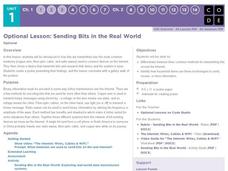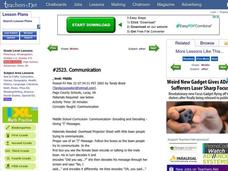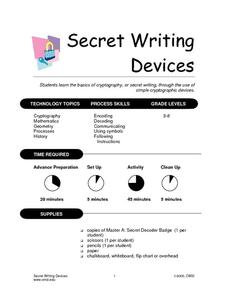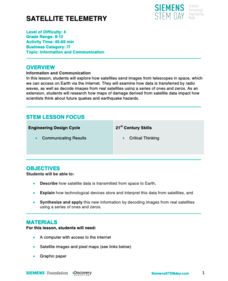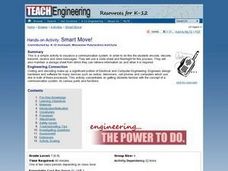Curated OER
Guide to Communicating
Teacher, project managers, or those in a vocational training program will understand how to communicate effectively. Work place communication, listening techniques, and communication models are discussed in a resource is specific to...
Code.org
Sending Bits in the Real World
A bit optional. How do computers transmit in the real world? Pupils research a device that is used in transmitting bits, then individuals create a poster that presents the information they have learned about their device.
Code.org
Encoding and Sending Formatted Text
Introduce your class to encoding text. Pairs work together to create a protocol to send text prior to learning ASCII encoding. Groups then collaborate to send and translate ASCII codes creating a formatted text message.
Newseum
Civil War: Encoding the News
Young journalists learn to appreciate the advantages of how modern media technology enables rapid news delivery as they compare today's media revolution to how the telegraph and Morse Code revolutionized news coverage during the Civil...
Curated OER
Binary and Communication Systems
Learners participate in an activity that introduces them to the concept of binary coding as a language. They decode messages using special boards that has its own code for different letters. They create new codes by rearranging wires...
Curated OER
Communication
Students practice how to be a good listener. They take a pre-test and then discuss their results. They also practice "I" messages in which they state how someone else's behavior is affecting them.
Curated OER
Communication - An Introduction
Young scholars define communication and identify its components. In this communication activity, students read, discuss, and internalize the four pages of communication elements that include charts, vocabulary, and methods.
Cornell University
Magnetic Mad Libs
Examine the science behind computer communication. After defining the properties of magnets, learners simulate how a computer hard drive works by sending each other binary codes using the magnets. They use these communications to...
Code.org
Sending Numbers
Binary graphing ... bit by bit. Pairs work together to develop a protocol in order to send the points of a graph. One partner sends the points and the other receives them and tries to recreate the graph. The pupils use the rubric to...
Curated OER
Secret Writing Devices
Elementary and middle schoolers explore the world of secret writing, otherwise known as cryptography. After an interesting introduction to the activity, learners utilize a decoder badge which uses the St. Cyr cipher - which is a cipher...
Curated OER
Encoded Meanings
Students explore symbols in art and complete related activities. In this art symbols lesson plan, students compare symbols they recognize to those of an African culture. Students create a collaborative work of art with symbols that have...
Discovery Education
Satellite Telemetry
Satellites require rockets to launch, but it doesn't take a rocket scientist to understand them. Future engineers learn about how satellites send data to Earth and how to interpret satellite images. They see how radio waves play a role...
Curated OER
Communications: To the Rescue!
Students role-play as soldiers rescuing lost mountain climbers. Working in teams, they interpret maps to locate the climbers and use flashlights to send and receive coded messages about the rescue. Their goal is to complete the task in...
Curated OER
What Does This Song Really Say?
Students investigate communication by analyzing lyrics from a song. In this music arts lesson, students discuss slavery, the Underground Railroad and African American traditions while listening to a song called "This Train." Students...
Curated OER
Communication in Bees
Eighth graders identify and interpret a scientific investigation and a hypothesis through experimentation and testing a hypothesis. They identify what scientists hypothesized about the communication of stingless bees. Finally, 8th...
Curated OER
Matrices: A Secret Weapon
Students perform operations with matrices. In this algebra lesson, students use cryptography and cryptanalysis to solve problems. They add, subtract, and multiply matrices.
Curated OER
Science Writing for the Masses: a Primer
Students demonstrate a basic understanding of the molecular basis of heredity. They discuss the chemical and structural properties of DNA and explain how genetic information is encoded in genes, replicated, transcribed and translated...
Curated OER
Smart Move!
Students visualize a communication system. They encode, decode, transmit, receive and store messages. Students use a code sheet and flashlight for this process. They will also maintain a storage sheet from which they can retrieve...
Code.org
The Need for Addressing
You sunk my battleship via the Internet? Groups of three play a modified game of Battleship using the Internet Simulator. Team members determine how to address messages, so each player knows who the message is for, and refine their text...
Curated OER
The Invention of the Telegraph
Students study the history of telegraph invention. For this technology lesson, students build their own Morse Telegraph System. They discuss how this invention benefits the society.
Curated OER
A Teeny Tiny Garden Alphabet Book
In this alphabet garden book worksheet, learners cut out, color and assemble a mini book. Each page has an alphabet letter and a picture of a garden-related object. Example: Kk- K is for Kohlrabi.
Curated OER
Theory of Codes
Pupils explore the concept of code theory. In this code theory lesson, students discuss noise, error correction, Hamming distance, parity check matrices, and cyclic codes. Pupils develop these concepts through practice and discussion.
Curated OER
Alphabet Letters A-Z and Alphabet Numbers 0-9
In this alphabet and numbers worksheet, students cut out and place in sequential order the uppercase and lowercase letters and numbers a-z and 1-10.
Code.org
Sending Binary Messages
Pairs build a device that will be able to send a binary message. They then update their device to allow it to send four possible messages before upping the ante to eight. The provided self-assessment rubric comes with reflection...



